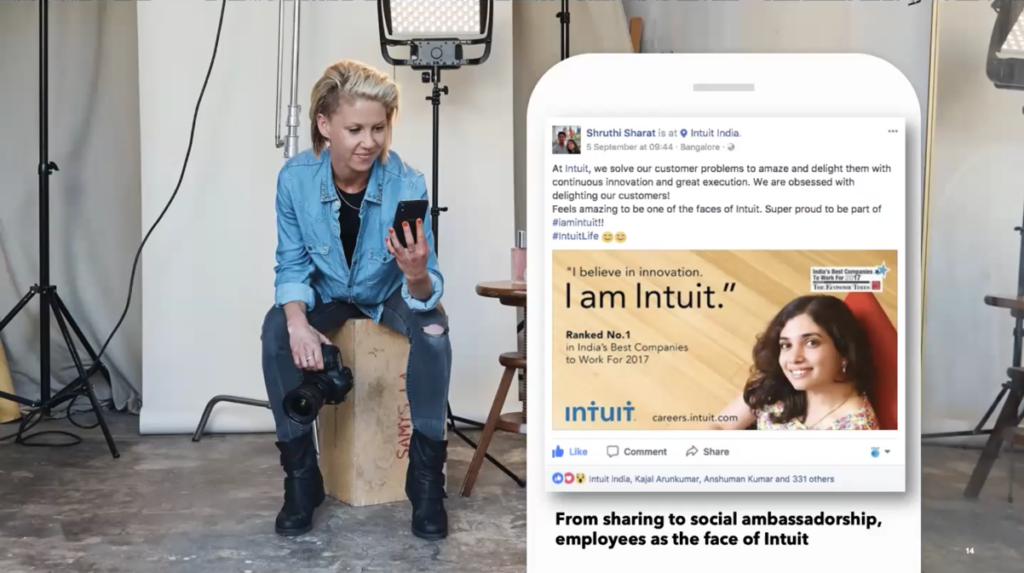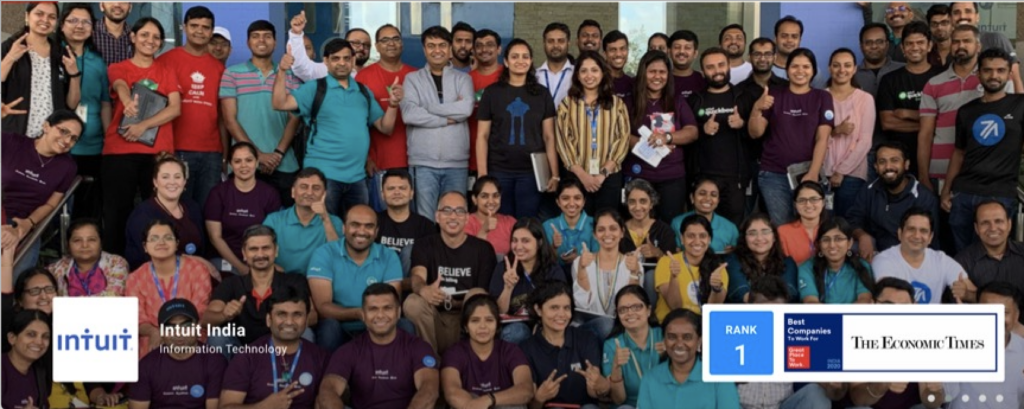As communicators of your brand, how can you form a strategy to stand out amidst the clutter and engage with your audience in a way that resonates and inspires them, incites behavioral changes and ultimately drives them to take action?
From my experience as a communications leader, I’ve come to see that establishing trust is at the heart of making the kinds of connections that lead to meaningful engagement — whether that is with customers or among employees.
Perhaps now more than ever, we are called as communicators to shift our perspectives to lead with empathy and allow our own biases to be challenged. By placing intentional re-invention and innovation at the heart of your strategy, you create space to continuously self-disrupt to stay relevant and valued.
By combining Intuit’s design thinking principles with the art of communication, I have narrowed to three key philosophies that have helped to shift my mindset and allow Intuit’s brand to grow and evolve organically to make a meaningful impact. It is my hope that these practices and shared stories can inspire you, communicators of the future, to explore this concept to build your brand and maintain trust with your own audiences.
Intuit’s Design Thinking Principles — CDI and D4D
Every company has its own way of connecting with customers or employees to inform its decisions and transformations. At Intuit, our process is guided by two frameworks: Customer Driven Innovation (CDI) and Design for Delight (D4D).
CDI is the foundation that creates a durable competitive advantage for us as a company and for our customers. Nearly 20 years ago, Scott Cook, one of Intuit’s founding partners, studied the characteristics of all of Intuit’s new product launches and found significant differences between the successes and failures. In each success story, three things were true:
- There was a giant, unsolved customer problem
- Intuit could solve this problem well (enlisting others as needed)
- We believed we could build durable competitive advantages.
In the failures, he found that one or more of these criteria were not true. Therefore, these three criteria were codified into the CDI framework to be used in our search for growth opportunities.

D4D is how we innovate. It's going beyond customer expectations in delivering ease and benefit, evoking positive emotion throughout the customer journey so that people buy with more confidence and tell others about their experience.

In the words of Scott Cook, “D4D is our No. 1 secret weapon at Intuit. There is no No. 2.”
D4D is a system that starts with deep customer empathy for the pain point they are experiencing, goes broad in seeking possible solutions, and then uses rapid experimentation and data to ultimately land on a solution.
With these two frameworks as its guiding stars, Intuit has established a legacy of self-disruption. Since its early days, the company’s leadership has remained committed to re-inventing itself unceasingly before its rivals do. In turn, this has made Intuit a long-standing, trusted brand that creates solutions that solve customers’ real problems.
3 Philosophies to Adopt a Mindset of Continuous Self-Disruption as a Communicator
Although CDI and D4D are traditionally used to guide product development processes, they have proven to be useful tools to inform successful internal communication strategies that ultimately can benefit your brand externally.
When I first joined the company, Intuit was not well-known in India. In addition to establishing Intuit’s presence in the tech ecosystem, I understood the importance of cultivating our local reputation as an extraordinary employer. I knew that if I could lean into the company mindset, our design thinking principles and our people, we could create ambassadors that would help share our culture outside of our walls.
As the needs and expectations of our audiences change over time, this requires a commitment to gaining and maintaining trust throughout their relationship with your brand. What follows (and shown in the graphic below) are three philosophies — deep empathy, value of partnership and power of many — along with supporting examples that conceptualize how you can renew trust with your audiences and adopt a continuous self-disruption mindset in your own practices.

With the commitment to renewing trust as your foundation to any effort, adopting these three beliefs will allow you disrupt your status quo and stay relevant.
1. Believe in Deep Empathy
As communicators, it feels counterintuitive to forfeit any control of your brand’s story or narrative. However, believing that your customers or employees can be not only partners in thought leadership to inform strategy, but also co-creators, can yield powerful results.
For this to be successful, you have to adopt a mindset that can be challenging for our profession: Trust must go both ways. You must be willing to trust that your customers and employees can not only amplify durably, but they can also be active participants in the co-creation of your brand narrative through its content, experiences and products.
Example: “I am Intuit” Campaign
In India, we wanted to test the hypothesis that an engaged employee could make the strongest brand ambassador. We conceived of the “I am Intuit” campaign, where we engaged real employees as content creation and execution partners. This included three core components:
- We invested in education. To have employees participate successfully, we helped them hone their social media skills and gave them tools to create their assets and own the process.
- We let them post first. We trusted our employees enough to allow them to be the primary content creators, and they posted the content themselves.
- We shared their stories. After the employees shared their own “I am Intuit” stories, Intuit shared their content on its owned channels.
This first successful experiment has continued to inform our social media strategies as we expand across channels and diversify our content.
2. Believe in the Value of Partnership
Why is this important? By gaining a deeper understanding of our audience, their pain points, and why and how they are currently doing something, we are given the inspiration to innovate for them and come up with solutions to change their lives. As communicators, it comes down to building a deeper connection between the audience and the brand’s values.
Example: Intuit India Facebook
In my early days at Intuit, we had no social media presence in India. I chose to run an experiment: I borrowed the concept of what Intuit calls “Follow Me Home,” a practice of observing a customer in their natural environment to learn from their behaviors and challenges.
We used this model to meet with Intuit India leaders and employees to understand what made our culture different. One thing that stood out was the great emphasis Intuit placed on celebrating employee milestones, namely the five-year employment celebrations. Leaders and employees alike spoke of the emotional highs shared as they celebrated stories of trials and accomplishments. But beyond that moment in time, the feeling was lost.
We created Intuit India’s Facebook page as a place to share this emphasis on milestones. In return we found:
- We grew followers quickly and our reach was expansive. This was an easy buy-in for our employees. They were keen to share this content with their networks, so they tagged friends and family and shared the posts. They wanted to be part of a digital community of celebration, and they wanted to share it out.
- Engagement on the page was very high. This channel gave employees a new way to engage with each other. We discovered that this was an outlet for some of our more quiet and shy employees to participate in a way that they felt comfortable.
- Our channel was perceived as authentic. By sharing our emotional highs with our digital community, those who engaged with our content were able to experience honest interactions with our brand.

When we launched this campaign, we hypothesized that our employees would be the best ambassadors for Intuit employer brand. The experiment led to these results:
- High employee participation: 50% of Intuit India employees used the tools provided to post their own “I am Intuit” content on their social media channels.
- Significant increase in average monthly impressions: +2700%, +313%, and +173% increases on Facebook, LinkedIn and Twitter, respectively.
- Traffic Spike on Careers Page: 44% traffic increase on the Intuit India careers page.
3. Believe in the Power of Many
Opening space for collaboration within your communication strategy is a meaningful step, but it involves an even greater level of trust to give others full autonomy to create, advocate and mobilize organically to help build and amplify your brand. By creating evangelists of your customers and employees, your brand will continuously find ways to stay relevant and innovative.
Example: Intuit’s Great Place to Work Ambassadors
It is a point of pride that Intuit sites around the world are recognized by the Great Place to Work Institute. This recognition serves as both a strong tool for external brand recognition and a yearly goal that motivates us as a company to continue making Intuit a place where employees can do the best work of their lives.
This has become so deeply ingrained into our way of life that an ambitious group of employees at our site in Bangalore, India, launched a Great Place to Work Ambassador program. Highly engaged employees that are passionate about Intuit’s culture volunteered their time to become voices for needed change and deserved celebration. Through these efforts, they continue to make Intuit India a better place to work for all, which in turn benefits our brand externally — earning us the Best Place to Work in India recognition in 2017 and 2020.

As communicators of the future, we must ask ourselves: How can we engage with our customers or employees with empathy? How will we challenge ourselves and our colleagues to adopt a mindset of continuous self-disruption? How can design thinking principles better inform our communication strategies? I hope through my own account you have had just a glimpse of the mutual trust that leads to the co-creation of a compelling, authentic brand.
At the 2020 Virtual World Conference, Anshuman presented “Continuous Disruption as the New Normal.” Review this session and others by purchasing one or more of the conference recording packages. View all available recording packages here.
Anshuman KumarAnshuman Kumar has spent almost two decades in the field of marketing and communications. A believer in collective storytelling, he joined Intuit in 2012 and led the charge to help establish Intuit as an employer of choice by empowering employees to evangelize and amplify Intuit’s culture. This unique employee-powered transformation helped Intuit rank as the No. 1 Best Company to Work For in India. The transformation was featured as a case study in Harvard Business Review. Anshuman has replicated similar successes across Australia, Canada and Israel, with Intuit featured among the Best Companies to Work For consistently across these global locations. Anshuman also leads Intuit’s start-up connect program, the Intuit Circles, engaging with the start-up ecosystem sharing Intuit’s design thinking approach and innovation methodologies to help start-ups grow and innovate at scale.